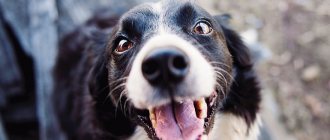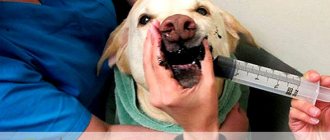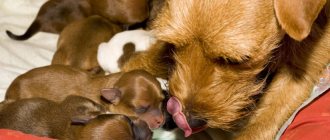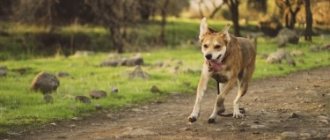Caregivers often associate their dog acting strange and hiding with suffering from illness. But the truth is that there are other reasons that explain this behavior in dogs besides pathology. For this reason, in this article we will look at the most common ones.
It is important that if our dog is hiding and not behaving as usual, we identify the source of the problem so that we can intervene, whether it is a physical or psychological cause. Read on to find out why your dog is weird and hiding.
Why do dogs often hide under the bed?
It is quite common for a dog to hide under the bed.
Let's look at the reasons why this happens and find solutions to eliminate these problems. According to experts and dog breeders, the reason may be the natural origin of dog breeds from wolves. Wolves dig their lair in the ground, since the dog is a direct descendant of the wolf, it retains the same genetic characteristics. The wolf’s den is protected by earthen walls on all sides, and a dog that has crawled under the bed is protected by a mattress on top, and on the sides by the walls of an apartment or house.
There is no need to fight nature, but take the genetic characteristics of dogs for granted and buy her a house made of padding polyester for dogs, which can easily replace a wolf’s den.
"Go into your shell"
It happens when an animal falls under the hot hand of its owner or hears how it is menacingly reprimanded in a raised voice for an offense. A dog is capable of feeling guilty and understanding at what point it upset its owner. In this situation, she adopts the tactic of retreating with a dejected look, waiting for the storm to subside. She is still ashamed to return to her favorite places in the apartment, so she will find additional points for herself where she can wait out the owner’s emotional outburst. He will wait an hour or two, and will boldly come out of hiding.
A change of scenery
Due to the owners moving to another house or apartment, the dog's behavior may change. Give the dog time to get used to the new place and the dog’s psychological state will return to normal.
The dog does not eat anything, moves sluggishly, drinks a lot of water. The dog's nose is dry and warm. These are clear signs that the dog is sick with an infectious disease.
Urgently call a veterinarian to your home so that he can examine the dog and prescribe the necessary medications for effective treatment of the disease.
The dog is looking for corners
Older dogs may suffer from something called cognitive dysfunction syndrome. Similar to Alzheimer's disease in humans, this may explain the dog being strange and hiding in search of corners. This is due to the deterioration of mental abilities, which progressively affects different areas. These include symptoms such as disorientation, looking for corners to hide, difficulty finding doors in rooms, not recognizing relatives, not responding to their names, sleeping more during the day and less at night, wandering, decreased activity, walking in circles, urinating at home, etc. If we detect some of these signs, we must consult a veterinarian to rule out any physical cause. Cognitive dysfunction can be treated.
Birth of puppies
After the birth of puppies, the dog’s body looks like a “survived lemon.” All this is due to the fact that the dog’s body during pregnancy gave all the nutrients and vitamins to the future offspring in the womb. With such severe exhaustion of the body, the dog’s mental state also changes. The dog becomes too aggressive or, on the contrary, very timid.
Is your puppy hiding under the bed? This is due to the fact that your puppy is playing with you. His psyche has not yet formed, so very often we cannot understand his behavior, even if it seems not entirely normal to us.
Not much time will pass and your puppy will become older, and the habit of hiding under the bed as a game will disappear by itself.
Resource protection
Dogs, when they find a treat in the form of a bone, can hide so that nothing distracts them from the long-awaited pleasure. In addition, they believe that the “delicious food” they find can be easily taken away. Still, you shouldn’t ignore this point, but it’s better to keep track of what exactly your pet is gnawing on. An interesting object may be new shoes or small valuables. The latter, if careless, can get stuck in the animal’s throat.
We also recommend reading:
The largest dog breeds What is domestication in animal husbandry Why you should get a cat: reasons voiced by scientists Euthanasia of animals
Why did the dog start hiding?
Cats were usually seen in something similar - these animals, in moments of danger (real and imaginary), always huddle in some kind of shelter. It’s hard to blame dogs for cowardice! Nevertheless, such behavior patterns do occur: the dog fearfully hides in a secluded place (for example, under a sofa or bed) and watches the development of events from there. Why is this happening? Fear? Something else? Let's think and reason.
Maybe it's even nice? First let's assess the situation. Were there any moments that could have caused fear or fright? Nothing like this even came close, and the dog, not without pleasure, climbs under the sofa - it is possible that he is simply comfortable there. Let's turn to the nature of these animals - they love to set up “dens” for themselves, where they feel relatively safe. At home, the space under the sofa can also serve as a den! We need to think logically about what exactly led the pet to this behavior: the house is noisy, annoying children, someone is constantly squeezing its paws. And even other, no less “harmful” and “annoying” pets.
Fear. Also an important reason. Actually, in moments of danger, a dog has two options: accept the challenge (that is, get into a fight) or run away. What exactly will your dog choose? It’s hard to say, depending on what the “threat” is. Does it come from a naughty child? The dog will be able to stand up for itself and demonstrate a defensive response. Another thing is unknown external threats: thunder, fireworks, other sharp sounds. Most likely, the pet will prefer to hide. The space under the sofa is small and relatively dark - ideal conditions to feel safe and calm. Observe the animal's body language: you will see flattened ears, a tail between the legs, hear a warning growl - it is better not to approach.
Fears and phobias in dogs, as a rule, are formed at a young puppyhood. For example, you could train your puppy using a spray bottle and splashes of water. This is enough for a phobia to develop. Every time you pick up a bottle of water (just drink it), the animal will experience severe fear.
Restless behavior as a sign of illness
Often the dog behaves restlessly due to the influence of so-called internal stress factors. That is, due to poor health, health problems.
Restless behavior as a sign of disease in dogs is noted when:
- neuroses, nervous disorders, pathologies;
- viral-bacterial, parasitic infections, which are accompanied by damage to the central and peripheral nervous system;
- renal colic;
- chronic, acute renal, liver failure;
- allergic manifestations (food allergies);
- disturbances in the gastrointestinal tract (acute intestinal disorder, food poisoning, chemicals, gastric volvulus);
- inflammation, blockage of the paraanal glands.
The dog may experience anxiety due to helminthic infestation, mycoses, dermatitis, dermatoses, or due to infection with ectoparasites.
Why does a dog hide in a dark place: let’s look at it in detail
Why does a dog hide in a dark place, under a bed or sofa, climb into a closet or pantry, hide in a corner and turn away? Quite a few dog owners are faced with this issue after noticing strange behavior in their pet. Where does this secrecy come from and could it indicate serious problems? Let's take a closer look.
While living with a dog, you have probably noticed that after playing, walking, active communication or eating, the pet goes to the same place. This behavior is explained by the desire for peace - this is a natural reflex and there is nothing strange about it. However, if your ward has become too secretive and hides most of the day, you should be wary. Below we will look at the probable causes of strange behavior and recommendations for eliminating them.
My dog goes into another room
If our dog is weird and hiding in another room, another possibility is that she is uncomfortable for some reason, which won't always be noticeable to us. This is a sign of disagreement. An example would be the case of taking the medication described in the previous section.
Another reason for hiding, although controversial, is that the dog is experiencing some remorse. This is a typical situation where a dog destroys something in our absence, and when we arrive, hides, does not look at us, etc. As humans, we interpret this as a sign of regret. The dog knows what he did was wrong and hides to avoid being reprimanded. The experts' explanation is that the dog, being an excellent observer of people, detects our early signs of anger and reacts to them by exhibiting submission behavior that is actually a product of fear. We say this is a controversial issue because there are dogs that hide before we even discover the mess. This may be due to memories of actions taken in the past being punished.
If this is your case and your dog is acting strange and hiding out of fear of your reaction, it is important to emphasize that punishment, yelling, fighting and of course physical abuse are not the solution. As you can see, these situations only cause a serious state of fear and stress, which can lead to even worse consequences. For this reason, it is important to use positive reinforcement to train your dog and to visit an ethologist if you need to change any behavior.
© shutterstock
Answer
The symptoms described are characteristic of a dangerous disease - distemper. The disease is contagious and has a viral etiology. The virus affects the animal’s brain and spinal cord, and in addition the respiratory organs.
In small puppies, the mortality rate from distemper is almost one hundred percent; in adult dogs, the chance of survival if timely access to the clinic is 50 percent. If your pet exhibits these symptoms, seek medical attention immediately.
The distemper virus is often spread by airborne droplets, but there is still a possibility of infection through food or water. In the animal's body, the pathogen settles in the blood and spleen. The virus leaves the body with physiological waste, saliva, lumps of hair or skin.
Infection can occur through sexual intercourse with a sick dog. The virus is transmitted on the host's clothing or with certain insects. Often the plague develops in the off-season.
Course and forms of the disease
In animals, distemper can have a lightning-fast course or occur in an acute or chronic form. In the fulminant form, the animal does not develop clinical symptoms and the dog dies instantly. Everything happens within a day at most. In the hyperacute form, the pet experiences a sharp rise in temperature, and the dog refuses to eat and drink. He quickly falls into a comatose state and dies within a few days.
The acute form of the disease is characterized by the characteristic symptoms listed above. The temperature rises, neurological reflexes are depressed, the dog is afraid of bright light and tries to hide. Inflammatory processes of the mucous membranes occur.
When epileptiform seizures and paralysis of the limbs appear, the prognosis of the disease is considered extremely unfavorable. The animal dies. If a dog has suffered the disease and recovered, in almost 100% of cases it remains handicapped: the sense organs suffer and neurological ailments develop.
Common Causes
Great importance in a dog’s restless behavior is given to its general condition, since the reason may lie in:
- Insect bites (fleas, ticks, ants, flies);
- Trauma;
- Contact with a foreign body under the skin;
- Poisoning;
- Development of internal pathologies.
Most often, this behavior is observed after operations, vaccinations, childbirth and taking medications.
In the summer it could be bees or wasps. After the bite, the dog becomes restless and rushes from side to side. In most cases, redness and swelling appear at the site of the bite. The most dangerous cases when
The bite site is in the area of the muzzle and neck. The main thing is not to hesitate, give your pet antihistamines on time and urgently take them to the veterinarian. Otherwise, there is a risk of swelling of the larynx and subsequent suffocation. If the animal is stung in the paw or back area, it is recommended to inspect the bite site for the presence of a sting, which must be removed.
Also, a dog's restless behavior can be caused by flea bites, which force the animal to itch terribly on all surfaces. Another characteristic feature is that the pet tries to chew out the fur. In the bald patches that appear, you can see flea burrows that look like a small red rash. Only anti-flea treatment using special preparations in the form of drops (Frontline, Advocate) and shampoo (Barrier, Sentry) will help here.
Ant and fly bites rarely cause significant discomfort to dogs, affecting their behavior. But, if an allergic reaction develops (often observed in English and French bulldogs), it can cause the pet to become fussy.
There are times when you may not notice that your dog has suffered an injury that will bother him and affect his behavior. Only after a thorough examination is it possible to find the abrasion or cut that is so disturbing to the animal. It is recommended to treat shallow wounds with an antiseptic to reduce the risk of infection and the onset of the inflammatory process.
Much attention is paid to oral injuries, namely cuts and bleeding gums, tooth loss and chips. Characteristic symptoms are refusal to eat and anxiety during examination of the oral cavity.
Splinters are a common cause of restless behavior in dogs at any time of the year. Even a small plant seed getting into the eye can make an animal anxious, and it is extremely difficult to find and solve this problem yourself. Things are simpler with splinters that get into the paw and torso. They are easier to detect, simply remove and treat the wound with an antiseptic. The veterinarian is often contacted with complaints of anxious behavior in a pet when there are no visual signs. But even a small splinter from a stick or a fish bone stuck in the gum can drive an animal crazy. Especially if the gums become suppurated.
Poisoning is not always accompanied by vomiting or diarrhea. Very often, one of the main symptoms that a dog has been poisoned is its restless behavior. She cannot find a place for herself and rushes around the house. A hard or swollen belly can alert the owner to the presence of a problem. In most cases, mild poisoning goes away on its own. As a preventive measure, you can give your pet enterosgel, which removes toxins from the body.
Eclampsia is a dangerous pathology observed in a dog immediately after birth. Due to a disturbance in calcium metabolism in the body, the animal begins to have convulsions, restlessness and an unsteady gait. A visit to the veterinarian in such cases is mandatory, as there is a risk of death! With timely
treatment, this problem is easily eliminated with the help of injections of sedatives and calcium-containing drugs. To prevent eclampsia during pregnancy, mineral supplements are indicated.
Gastric volvulus is a common phenomenon among some breeds (Great Dane, Doberman, Labrador, German Shepherd), which, if symptoms are ignored, leads to 100% mortality. The main signs are the sudden onset of restless behavior in the dog. She cannot sit still for more than a few seconds, whines, and may unsuccessfully try to vomit. Often happens after heavy feeding. The reason may lie in the structural features of the chest and stomach. The only solution to the problem is surgery.
Epilepsy is an incurable brain disease that most often affects poodles, dachshunds and Labradors. In other breeds, trauma and infection can trigger epilepsy. Distinctive signs are attacks during which the dog becomes restless, does not follow commands and behaves inappropriately. In severe cases, tremors of the limbs and foam at the mouth may occur. The first attacks occur as early as 6 months. Owners can help improve the condition of their pets during an attack with the help of sedatives, but they will not be able to get rid of this disease once and for all.
Should I worry if my dog is acting restless? First, you need to understand that there are psychological reasons for restless behavior in dogs. Diagnosis of psychological abnormalities is complex and is carried out only if the pet is healthy.
If the animal itches
The animal itches and looks restless for the following reasons:
- Prolonged stress.
- Obvious mental disorders.
- Parasites.
- Allergy.
With obvious mental disorders, the dog scratches the skin until it bleeds. Quite often, you can observe your pet licking its front paws. When the dog is excited, he often and nervously licks his muzzle. Such conditions can be treated with long-term therapy, massage, changes in feeding and walking schedules, and increased attention from the owner.
Your dog may be itchy and anxious if he is infested with fleas, ticks, or other parasites. To protect your pet from unwanted “neighbors,” you need to carry out preventive measures once every 1–3 months, depending on the drug chosen.
The dog is nervous before traveling or in the car
Severe anxiety before traveling or in the car is a natural reaction of a dog. It is important to understand what a pet experiences if its trajectory of movement is not under control.
Note! Before and during travel, veterinarians recommend the use of sedatives.
Breathes frequently with mouth open
When a dog is anxious and frequently breathes with its mouth open, the reason is overexcitement or an increase in body temperature. Overexcitement does not always threaten the pet's health, since the dog can experience strong emotions of a positive nature.
The dog has its tail between its legs
If your dog is anxious and has a tucked tail, the most likely reason is:
- Self-doubt.
- Competitive environment.
- Physical pain that causes the dog to feel insecure.
A tucked tail can indicate distress or a willingness to submit. To determine the real reason, the dog's behavior must be analyzed comprehensively.
How to help a dying dog
To make it easier for your pet to pass away, you should observe how the dog behaves before death. A dog's behavior before death always changes, and an attentive, loving owner cannot fail to notice this. If a dog dies easily, then he needs nothing but peace and quiet, and sometimes the presence of his owner. Many dogs lick their owners' hands and wag their tails even in their last moments of life.
If dying is associated with the dog’s physical suffering, then the owner’s duty is to alleviate his condition and decide on euthanasia or consider all options for a worthy farewell to his final journey. This is not murder, as many people think, but the last help to someone who has been around for many years and who helped cope with everyday difficulties as best he could.
Euthanasia is necessary for animals dying from cancer, head injuries, multiple bleeding, or an incurable infectious disease. Only a veterinarian can perform this.
Currently reading:
- Tips for proper dog burial
- The American Cocker Spaniel is an adroit hunter and loyal friend.
- Games to choose for training a dog
- Recommendations for obedience of a dog if it growls











